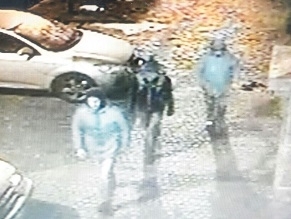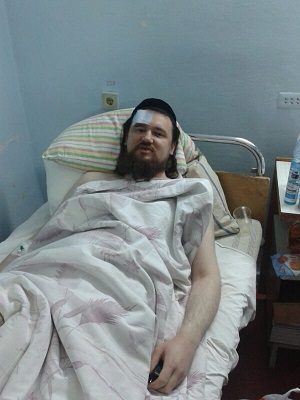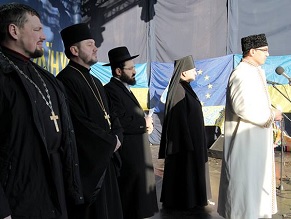|
Analytics

Men who attacked Hillel Wertheimer on January 11 (photo from outdoor surveillance camera).
|
Attacks on Jews in Kyiv: Facts and Interpretations
19.01.2014, Xenophobia and anti-Semitism Vyacheslav Likhachev
Over the last ten days several serious and possibly anti-Semitic incidents took place near the Rozenberg Synagogue in Kyiv’s Podil district. These incidents have caused great concern for the Jewish community and have already aroused the interest of foreign media. Many of these incidents’ details are as of yet unclear, but it is already certain that nothing like this has happened in the Ukrainian capital since the mid-2000s. Since 2008 – 2009, Ukraine in general and Kyiv particularly saw a stable and systematic decline of all illegal manifestations of anti-Semitism, first and foremost - of Judophobic street violence. Both this fact and the seriousness of the incidents force us to give the situation our utmost attention and attempt to analyze the changes in anti-Semitism in Kyiv. As nearly all Jewish media on the Internet that have already reported the incidents hurried to scoop the competition, they have made many glaring errors and absurd incongruities. I will thus have to begin with a scrupulous, even somewhat pedantic, presentation of the facts of the case.
Surveillance and attacks
The first incident took place on the evening of January 11, right after the end of the Sabbath (that is, after the sun set on Saturday). After the Saturday evening prayer, outdoor surveillance cameras caught sight of two pairs of young men who were waiting for something on opposite sides of the synagogue. Unfortunately, it is impossible to see their faces, which were covered by scarves or flu masks, and additionally concealed by lowered hoods. Excluding this pecularity, nothing in their clothing gave away any ideological predilection or affiliation with any organization. It was just normal clothing popular among youth: half-sports, half casual, suitable for the weather.
Hillel Wertheimer, a 26-year-old Israeli teacher of Hebrew and Jewish Tradition, left the synagogue at approximately 6 PM. The teacher was easily distinguishable as an Orthodox Jews. The youths merged into one group and followed Wertheimer at a distance until his home on Yurkovskaya street. Wertheimer entered the lobby of his apartment building at about 6:10; the youths ran in after him and attacked. A neighbor of the teacher’s heard screams and went to check what happened. Her presence scared off the attackers, who broke off and ran. Luckily, they didn’t have time to inflict any serious wounds.
The victim then called the police. Criminal proceedings were opened, and preliminary assessment qualified the case according to Article 125, Part 1 of the Ukrainian Criminal Code (“intentional infliction of light bodily injury”).
The attack did not garner a wide resonance. There were isolated reports in foreign Jewish media, but the Ukrainian news made no note of the incident.
Less than a week later, a more serious incident took place.
On Friday, January 17, at about 11:15 PM, after the traditional welcoming of the Sabbath (which takes place on Friday night according to Jewish tradition) was long over and most of the worshippers had already left the synagogue, a 33-year-old Yeshiva student from Russia, Dov-Ber Glickman finally decided to leave himself. He turned left from the building and walked down Schekavitskaya street towards Voloshskaya street. But some 50 meters before the crossroads, he saw that three suspicious young men were standing on the street corner. They were wearing combat boots and their faces were concealed by hoods. Naturally, everyone in the community knew about the week-old incident with the teacher and were alert. Dov-Ber Glickman decided to avoid them and tried to escape though a nearby courtyard. He walked onto Voloshskaya street somewhat further than its crossroads with Schekavitskaya street. But the criminals who were waiting for a victim saw his maneuver and walked after him quickly. Upon hearing that his pursuers broke into a run, the student turned onto Vvedenskaya street, but they caught up with him several meters later. One of the pursuers walked out into the traffic area of the Voloshskaya-Vvedenskaya crossroads and watched the situation, and two more silently attacked the victim. They hit him both with their fists and with their legs, and their combat boots seem to have been outfitted with blades that left deep gashes. The attack took place near an apartment building, and the victim had been able to keep his footing and remain standing. Local residents awoken by the student’s screams tumbled out onto their balconies, somebody shouted from their window. Then the attackers broke off, ran towards their accomplice who had been keeping watch, and all three of them got into a car standing at the crossroads with its headlights on.
 Dov-Ber Glickman realized that he was wounded and made it back to the synagogue, where he asked the guard to call an ambulance. Ample traces of blood remained in the synagogue mikveh room (a bathing facility used for ritual purification). First aid was given to Glickman by the ambulance medical workers, who had arrived promptly. Glickman had then been taken to a hospital, where the doctors closed three punctured and incised wounds.
It is important to note that neither the Schekavitskaya-Voloshskaya crosrroads nor the Voloshskaya-Vvedenskaya crossroads have no outdoor surveillance. The criminals were obviously intentionally waiting at a distance from the synagogue with its cameras. It is possible that they have taken into account the mistakes they had made during the first attack.
So far there is no information on criminal proceedings being opened. On Saturday, January 18, two men in police uniforms visited the victim at the hospital and took a statement from him. However, due to Jewish religious prohibitations, the Yeshiva student had been unable to sign the protol written according to his statement.
One more episode that looks rather sinister in light of other events has also so far gone unmentioned by the media. After the attack at night, the Yeshiva students organized something like a patrol on Saturday. The improvised patrol walked the streets surrounding the synagogue, accompanying worshippers to and from prayer meetings. After the day’s prayer they noticed a suspicious young man who had, according to one of the worshippers, been following him. The young man looked about 19 and, according to the students, looked like a skinhead: he had a short haircut, high combat boots, and a short jacket. The three activists from the improvised patrol detained the young man. He did not resist and, according to the students, was very sure of himself, even impudent. The youth had a notebook in which he had been sketching a detailed plan of the blocks near the synagogues with some kind of arrows. The activists believe the young man to be a “scout” (youth group slang), who had been writing down how the worshippers returned home from the synagogue.
The improvised patrol handed the detained youth over to the police. The young man continued his impudent behavior even with them around. After an identity check, the young man was released from police custody.
The Yeshiva students say that they had seen other suspicious young men near the synagogue but were unable to detain them. And one cannot say for certain that the total surveillance placed onto the synagogue is not just a fruit of the patrol’s imagination, nourished by the incidents that have already happened.
Interpretations and Theories
Naturally, when a series of such incidents takes place after several years of stability and peace, different versions are voiced to explain the sudden change in circumstances. So what is happening with the Rozenberg Synagogue and anti-Semitism in Kyiv as a whole?
The first notable thing is that the incidents are almost indubitably anti-Semitic. Even though there is no direct proof (no anti-Semitic slogans or insults yelled out during the attack, no neo-Nazi symbols on the clothes of the attackers), this is fairly obvious. Neither the Yeshiva teacher nor the student had any prior contacts with the local hooligans. Other students had had such conflicts, but they were purely personal. The attacks were obviously planned before hand and thought out, especially the second, more cruel attack. The first incident also shows that the criminals knew when the congregation would be leaving the synagogue after the Saturday evening prayer.
So how did an organized, motivated, and capable of rationally planning a crime neo-Nazi gang suddenly appear in the streets of Kyiv?
Of course, a coincidence cannot be ruled out entirely. Even though the level of anti-Semitic violence is very low in Ukraine, sometimes attacks do happen. In 2012 some youths, seemingly belonging to one group, attacked two people in Rivne in a small period of time: the rabbi and the community leader, chairman of the local “Chesed” (Jewish charity fund). In 2007, a group of neo-Nazis terrorized Zhytomyr’s Jewish community by attacking members of the congregation returning home from the synagogue. These are, of course, stand-alone incidents, but coincidence can never be counted out entirely. Ukraine does have fringe neo-Nazi youth groups, and dozens of people annually are attacked by racists. The Jewish community shouldn’t become complacent merely because Africans and Asians are the usually victims of hate crime, as there are no real deterrents that would stop motivated fanatics from choosing another object.
But there are, of course, more conceited versions of the Podil events. Right after the first incident, one Israeli journalists stated that “the situation with anti-Semitism in Kyiv has been worsening over the last month and a half, possibly as a result of the street riots happening in Ukraine’s capital due to the protest movement.” Despite writing an analysis, the journalist also managed to get the date of the incident and other details wrong. Even though earlier this “worsening” showed itself only through graffiti left on fences by the fringe national-radical youth wing of the protest movement, but this interpretation in general has the right to exist. The attack on the Yeshiva teacher was commented on in a similar fashion by the co-President of the Jewish Confederation of Ukraine Boris Fuksman for the World Jewish Congress. I have strong suspicions that the explanation for these anti-Semitic attacks which will become the most popular in the media will likely connect them to the civil protests.
So just how likely is this connection? The large-scale civil protests known under the title “Euromaidan” really do include groups of radical youths whose slogans and actions repel even the nationalistic All-Ukrainan “Svoboda” Union Party. Considering that many activists have come to Kyiv for the protests, it is true that the number of radical right adherents in the capital’s center is fairly high. It is true that these guys have no love for minorities and focus on physical violence. But it is completely illogical that the national radicals would remember the Jews now of all times, after almost two months of participating in the protests. Last week the activists of radical right groups involved in protecting the Maidan in Kyiv’s center had many a sleepless night as were preparing for an assault by the police and hired thugs (known in Ukrainian political slang since last year under the appellative “titushky”). After the parliament passed and the president signed a number of repressive laws, including some aimed directly against what the government said was “extremism,” the entire opposition has been preparing for mass events on January 19. This includes the radical wing of the protesters, who have been holding rather heated discussions on acceptable means to combat the government. Considering the general direction of what is happening on the Maidan, I believe that even the most thuggish of the protesters are not interested in Jews at the moment. Finally, the Central Brodsky Synagogue is far closer to the protest headquarters. If someone really wanted to take out their anger at the government’s actions on the Jews, it would have been far easier to simply jump someone on Shota Rustavelli street and in fifteen minutes be back under the protection of the barricades or even the doors of the House of Unions’ fifth floor, tightly closed and guarded by faithful allies. There is absolutely no need to make a detailed study of the approaches to Podil’s synagogue and to have a car ready for departure from the scene of the crime.
 I also heard a version that the special interest of the neo-Nazis to the Podil synagogue is due to Rabbi Hillel Cohen belonging to this very community. Rabbi Cohen had called for peace from the Euromaidan stage and participated in an interfaith prayer that took place as part of the People’s Assembly “Solidarity Against Terror” on December 29. Some people have been making serious conjectures that the people behind the attacks are members of ultra-nationalist groups, particularly Svoboda, who were not happy the rabbi spoke at the Euromaidan. It is obvious to me that this version holds no water. On the contrary, I believe that the public support of the protest movement by representatives of the Jewish community, such as rabbi Cohen or the Chairman of the Association of Jewish Communities and Organizations of Ukraine Josef Zisels, has significantly lowered the aggressive anti-Semitic potential of the fringe ultra-nationalistic youth groups participating in the Euromaidan. The panicked expectations expressed from the very beginning of the rallies by certain representatives of the Jewish community, who had been trying to maintain a good relationship with the current government, had no basis in reality whatsoever until the last several days.
Hatred is, of course, irrational. But the details of the crimes seem to be pointing to a well-calculated plan rather than to a flare-up of hatred.
If what has happened is not a coincidence but is somehow connected to the most important and large-scale processes happening in today’s Ukraine - that is, with the conflict between civil society and the government - then what triggered it? What is new in the situation at hand since the end of November, what changed just recently?
The first thing that comes to mind is the laws passed on January 16, which do not only make any public protest illegal but also include separate laws aimed against rather broadly understood hate crime and national extremism.
Near New Year’s, over two weeks ago, I gave an interview to a Jewish newspaper, in which I said, “The government is making constant appeals to a possible threat to national minorities from national radicals. Their noticeable presence in the protest movement gives pro-government political propagandists a serious advantage. Moreover, I believe that political technologists working for Bankovaya are ready to create news hooks themselves by ordering unacceptable provocations, like it happened in Cherkasy in April 2013, when aggressive youths with t-shirts that read “Attack the kikes!” came to a rally of the opposition. I admit that since the actual level of anti-Semitism is stable and rather low, I am afraid that pro-government political technologists might actually send someone to, for example, break windows in a synagogue. Of course, someone would also have to write “Svoboda’s” slogans and part name on the walls, too. Or maybe commit something even more convincing.” I ask forgiveness for the self-citation; this is an incident where I would have been happy to be wrong.
Yet what happened is very convincing. It is possible that the second, more cruel incident happened due to the first not having enough resonance in the media. The next several days will likely show us how the events at hand are developing: how the media depict the situation with Ukraine and anti-Semitism and whether the government will begin its attack on protesters from the radical wing.
I do not want to spin a conspiracy theory here. Fifteen years of experience in monitoring hate crimes tell me that usually hate crime is just a hate crime and not an element of some complex and global political plot. Racists attack those whom their fevered imagination designates as enemies of their race, simply because they are racists.
But one cannot deny that we have little cause for doubt in the cynicism and cold calculativeness of the strategists working on keeping the current government standing in the face of civil unrest.
On photo in the middle: Dov-Ber Glikman in the hospital, January 18; on lower photo: joint Jewish, Christian, and Muslim prayer for peace at Maidan, December 29.
|
|
